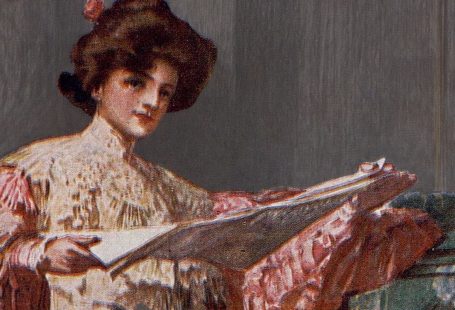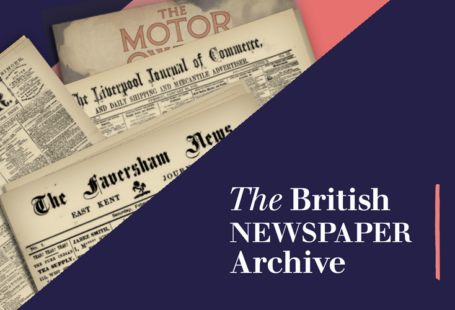Over the past seven days at The Archive we have added 117,702 brand new pages, with eleven brand new newspaper titles joining us over this period alone. We have added three new local titles (from Wiltshire, Buckinghamshire and Kent respectively), with eight of our new titles this week coming from the British Library’s Heritage Made Digital programme.
So read on to discover more about all of our new newspapers of the week (which include amongst them four Victorian illustrated papers), as well as to find out more about all of the updates we have made to our existing ones. Meanwhile, we delve into the pages of the Tichborne Gazette to discover more about the fascinating story of Sir Roger Tichborne, and a legal case which captivated the Victorian public.
Register now and explore the Archive
Our three new local newspapers of this week have one thing in common – they all begin with ‘W.’ And starting us off this week is Kent’s Westerham Herald. First published in 1882, the publication’s full name was the Westerham Herald and Edenbridge, Limpsfield, Brasted, Sundridge and Oxtend Journal and somewhat unusually, it appeared on a monthly basis.
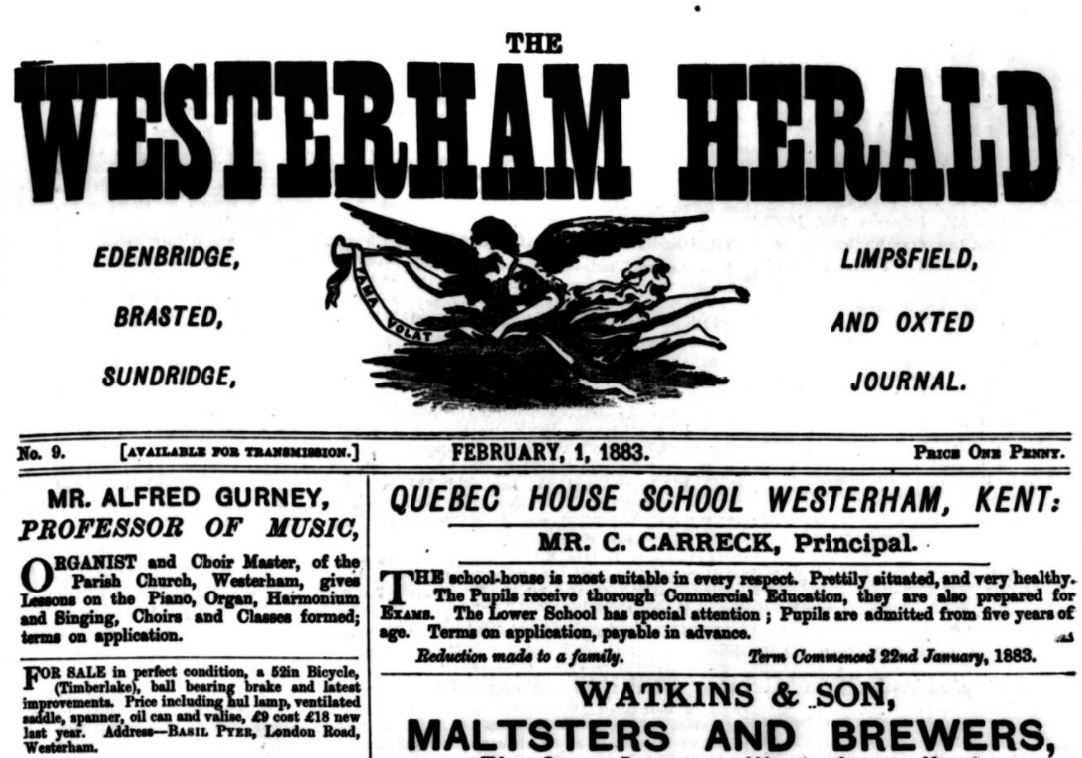
Printed in the West Kent town of Westerham, which lies near the Surrey boarder, the Westerham Herald reported on a range of local news, recording the latest, for example, from the ‘Edenbridge Fat Stock Corn and Root Show,’ and from towns like Sevenoaks and Hever. It also featured serialised fiction, featuring tales like ‘Old Mervin’s Crime’ by Eugenie Serle, as well as the local railway timetables.
The Westerham Herald became weekly in 1894 and changed its name to the Westerham Herald, Kent and Surrey Gazette, before closing in 1935.
Our next new title of the week hails from Buckinghamshire, and is the Wolverton Express. Published in the railway town of Wolverton, which lies near Milton Keynes, the Wolverton Express was first published on the 17 April 1901 and cost one penny. With a focus on local stories, the publication’s full name was the Wolverton Express and Stantonbury Herald, Stony Stratford Standard, Bletchley Journal, and Towcester Times.
In its first edition, the Wolverton Express addressed its readers and laid out its aims:
…the Express will move with the times, and to be ahead of them rather than behind them. We shall endeavour to serve up news as fresh and up-to-date as can be obtained… [and] to provide a comprehensive and accurate record of all local news, and a bright and succinct summary of the general news of the week.

The four page newspaper also pledged itself to be politically independent, stating how it would ‘know no difference of party or creed,’ and how it would be ‘a neutral platform from which all classes and parties may make a free expression of their views.’ Meanwhile, with Wolverton being ‘in the heart of a great football, cricket and athletic district,’ the Express promised that ‘devotees of these several sports will be able to find a chronicle of local events connected with these popular pastimes.’
To this end, the Wolverton Express featured extensive ‘Sporting Notes’ and reports on local football matches, as well as local news stories like ‘Death of a Bucks Centenarian.’ It also featured special interest columns, with one directed at ‘Mothers and Daughters,’ and another entitled ‘Arts and Letters.’ The comprehensive weekly newspaper also featured a ‘Local Directory,’ and a ‘Weekly Calendar,’ which gave times of the religious services in the district.
Rounding off our trio of ‘W’ newspapers is Wiltshire’s Warminster Herald. Published in the market town of Warminster, which sits near the western edge of the Salisbury Plain, the Warminster Herald was first published on 7 March 1857 and cost one penny.

Appearing every Saturday, the town’s market day, the Warminster Herald was Liberal in its politics and offered ‘a good digest of the local and general news.’ Published by Frank Evans, the newspaper circulated in Wiltshire, Somerset and Dorset, and had a particular focus on international news. For example, within its pages you can find such columns as ‘Foreign Intelligence,’ ‘Foreign Gleanings,’ and ‘Latest from Abroad,’ covering items from a ‘tragedy’ in New York to a rebellion in China.
Meanwhile, the Warminster Herald featured the latest from Court, as well as ‘Parliamentary Intelligence,’ news of the week’s ‘Accidents and Offences,’ provincial news, and updates from Scotland and Ireland. The newspaper, faced with competition in the town from a new newspaper, ceased publication in 1893.
Our next new titles of the week are brought to us by the British Library’s Heritage Made Digital project, which concentrates on digitising newspapers that are in a poor condition. The first of these newspapers we will take a look at is Cosmopolitan (which is not to be confused with the modern magazine of the same name).
Cosmopolitan was first published on 7 October 1865, and promised that its focus would be on ‘News, Politics, Commerce, Literature, Art and Society.’ Its first edition offered an unusually candid statement of intent:
The object of the publication, frankly confessed, is two-fold – to make money and disseminate information.
Professing to be ‘neither the organ of any sect or party,’ Cosmopolitan promised to offer its readers news from across the world, its first edition stating how:
Deriving information from all parts of the globe with agents and correspondents in many leading towns and cities, the Cosmopolitan will endeavour to make itself as acceptable to the lonely reader in distant Oregon or Australia as to the crowded cosmopolite of London or Paris.
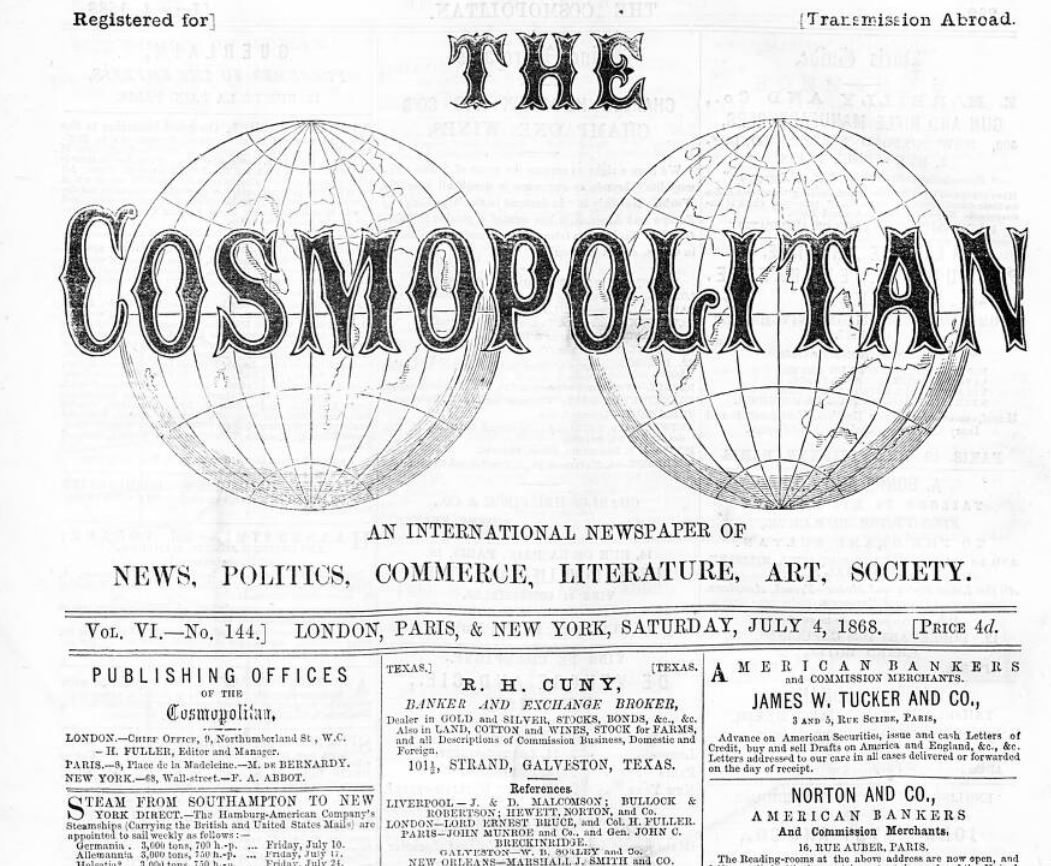
To this end, Cosmopolitan featured the latest from the English, Continental and American press, featuring letters from Paris, Florence, Liverpool and New York, as well as a ‘Paris Chronicle’ and further correspondence from the French capital. Meanwhile, the newspaper also featured ‘Shipping Intelligence,’ ‘Religious Intelligence,’ as well as literary news and the latest from the theatres.
Finally, Cosmopolitan positioned itself as fairly radical politically, its first edition remarking how:
It will advocate the universal right of suffrage regardless of race or colour…it will oppose the next war, no matter where or wherefore, as hell upon earth and the sum of all misery.
We now move on to the first of our four illustrated titles this week, which hails from the Midlands, and Birmingham, to be precise. The Illustrated Midland News was first published on 4 September 1869 at the cost of three pence, from 108 New Street, Birmingham. Its first edition laid out its ‘Prospectus,’ and how ‘the people of this great and thriving District will appreciate and value a Pictorial newspaper,’ one that would occupy ‘as high a position as the Illustrated London News does in London.’

The first edition also stated in its ‘Prospectus’ how:
The Illustrated Paper for the Provinces will be devoted chiefly to the intelligence of the Midland Counties. The important Local and General News of the Day will be carefully narrated, and incidents of note will form subjects for Pictorial representation. Artists of high repute have been engaged…the Illustrated Midland News will not only be a First-class Newspaper; it will be a Pictorial Record of Local, General, and Foreign Events.
True to its local remit, the front page of the first ever Illustrated Midland News depicted the South Staffordshire Fine Art and Industrial Exhibition, which was held at Molyneux House, Wolverhampton. Within its pages you could also find illustrated renderings of the orphanage at Erdington, the needle works at Redditch, scenes from rural and urban life (including a Parisian street scene), as well as poetry accompanied by illustrations, such as ‘The Mermaid.’

Meanwhile, the Illustrated Midland News promised to appeal to the various local industries, such as the ‘Arts and Manufactures’ of Birmingham, the mining industry of Staffordshire, Nottinghamshire and Derbyshire, the ribbon making in Coventry, the porcelain production in Worcester and the agriculture in Warwickshire, Gloucestershire, Shropshire, Worcestershire, Herefordshire and Oxfordshire. To this end, the newspaper featured columns like ‘Midland Exports to America’ and ‘Birmingham and Midland Trade.’
By 1871 the Illustrated Midland News had expanded its scope and moved to London to become the Illustrated Newspaper, which was first published on 18 March 1871. Costing three pence again, it described itself as an ‘Established Favourite, with a New Title and a Broader Purpose.’ Indeed, as the Illustrated Newspaper it hoped to ‘adapt to the Wider Circle of Readers which has grown up outside of its First Home of Birmingham and the Midlands,’ becoming a ‘London and County Family Paper.’

The first edition of the Illustrated Newspaper featured as its front cover a charming scene from everyday London life, entitled ‘The Early Coffee Stall – A Sketch Near Hyde Park Corner.’ It also featured a range of illustrations, depicting French refugees leaving Charing Cross, Lichfield Cathedral, Norwich election petitions, King Alfred, and portraits of Princess Louise and her husband the Marquis of Lorne.
Meanwhile, the Illustrated Newspaper set out ‘to prove that an illustrated paper equal to the best pictorial journals of the day can be produced for three pence,’ believing how it was set to be ‘the most popular work of its kind ever produced.’
Our next illustrated title is the London Illustrated Weekly. Eccentric and lively, this newspaper consisted of eight pages and appeared every Saturday, priced at one penny. ‘A Family Journal of News, Tales, History, Art &c.’ it was published by W.E. Goulden at the Office, 271 High Holborn.

Featuring both international and national news, the London Illustrated Weekly contained articles covering such subjects as the ‘New Orleans Carnival,’ ‘An Italian Tragedy,’ ‘How Livingstone Was Bit by a Lion,’ and ‘A Tale of English Mail-Coach Days.’ It also featured fiction enlivened by illustrations, such as ‘The Treasure Hunters or the Search for the Mountain Mine’ by George Manville Fenn. Meanwhile, the London Illustrated Weekly contained a variety of special interest columns, featuring a ‘Ladies’ Own Corner,’ which looked at the latest fashions from Paris, and a ‘Flower Garden and Kitchen Garden’ section.
Our final illustrated title this week is the Illustrated Crystal Palace Gazette. This monthly newspaper was first published on 1 October 1853, and it was dedicated to chronicling the reopening of the Crystal Palace at Sydenham Hill, where it had been moved after the Great Exhibition of 1851.

The first edition addresses its ‘Public’ as follows:
Every monarch has his laureate – every hero his historiographer…Victoria has her Tennyson…Why should the People’s Palace be an exception to this modern form of an old-world rule? The Crystal Palace again approaches completion – a more perfect and permanent form is about to be given to the Industry of All Nations – and up to the moment of this writing, no special chronicle of its progress and exponents of its Treasures is in existence. That vacant office the Illustrated Crystal Palace Gazette aspires to fill.
Indeed, the Illustrated Crystal Palace Gazette was intent on calling the Crystal Palace the People’s Palace, for the exhibitions it was set to contain had the potential to educate the masses, and so it was not ‘merely a spectacle or playground – an English Versailles, or upper Vauxhall, an Alhambra of pleasure.’ And so, the ‘primary purpose’ of the new Palace publication was to ‘chronicle the progress of the Palace and the Exhibition,’ endeavouring to ‘analyse and illustrate their contents.’

So within the pages of the Illustrated Crystal Palace Gazette, which was published by A & S Cockshaw from Ludgate Hill, you could find descriptions and illustrations of the various exhibitions to be found at the Crystal Palace, as well as articles discussing the infrastructure and the issues facing the building of such an edifice, including ‘Sydenham and Its Want of Drainage.’ The newspaper also featured original poetry, and ‘The News of the Month.’
Our next new title of the week is the South London Advertiser. First published in 1862, the South London Advertiser was a weekly newspaper which appeared every Saturday priced at one penny. Featuring a range of international and national news, including the latest from France, Mexico, China, Rome and America, as well as reports from Birmingham, Lancashire, and the local London area, the South London Advertiser also featured a range of special interest columns, such as ‘The Arts and Literature,’ ‘Political Gossip’ and ‘Farming and Gardening,’ alongside two pages of advertisements.
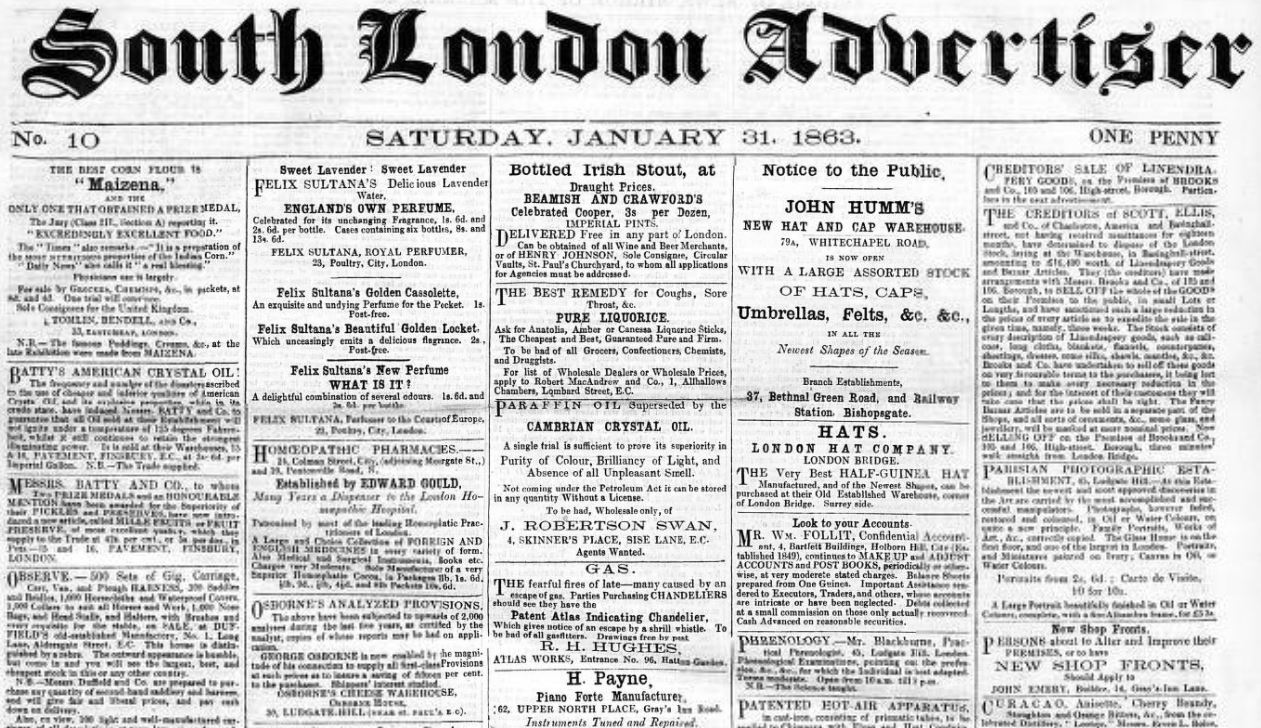
Our penultimate new title of the week is the historic Surrey Herald and County Advertiser. First published from 46 Fleet Street on 20 December 1826 at the cost of seven pence, the Surrey Herald appeared every Wednesday and consisted of four pages. Containing both national and international news, for example the latest from Madrid and news of a fire at Bristol, this newspaper also had a heavy bias towards police and law news, featuring reports from the Old Bailey and Bow Street.
The Surrey Herald also contained news of accidents and offences, shipping intelligence, as well as news from the theatres in a column entitled ‘Green Room Echoes.’ The newspaper sometimes also included illustrations, its first edition for example showcasing a portrait of Donna Isabel Maria, Princess Regent of Portugal, whilst in January 1827 its front page pictured the funeral of Prince Frederick, the Duke of York, brother to King George IV.

We have one more new title this week – the wonderful Tichborne Gazette – but more on that later!
Meanwhile, we have updated eighteen of our existing titles this week, with updates to two of our specialist titles, entertainment publication the Music Hall and Theatre Review and shipping newspaper Lloyd’s List. We also have extensive updates to two of our Lincolnshire titles, numbering over 20,000 pages in all, with pages added to the Grantham Journal and the Spalding Guardian.
The Case of Sir Roger Tichborne
We have saved perhaps the most fascinating of our new titles to the end – the Tichborne Gazette. The Tichborne Gazette was first published on 28 May 1872 at the cost of one penny, to further the cause of man who claimed to be Sir Roger Tichborne.
The Tichborne case was a veritable cause célèbre of the Victorian era. Sir Roger Tichborne, the young heir to his family estates, was travelling at the age of 25 in 1854 when he disappeared, and was supposed to have been killed in a shipwreck. However, news reached his mother Lady Tichborne that he may have reached Australia, and so she advertised extensively in that country in the hopes of finding her son.
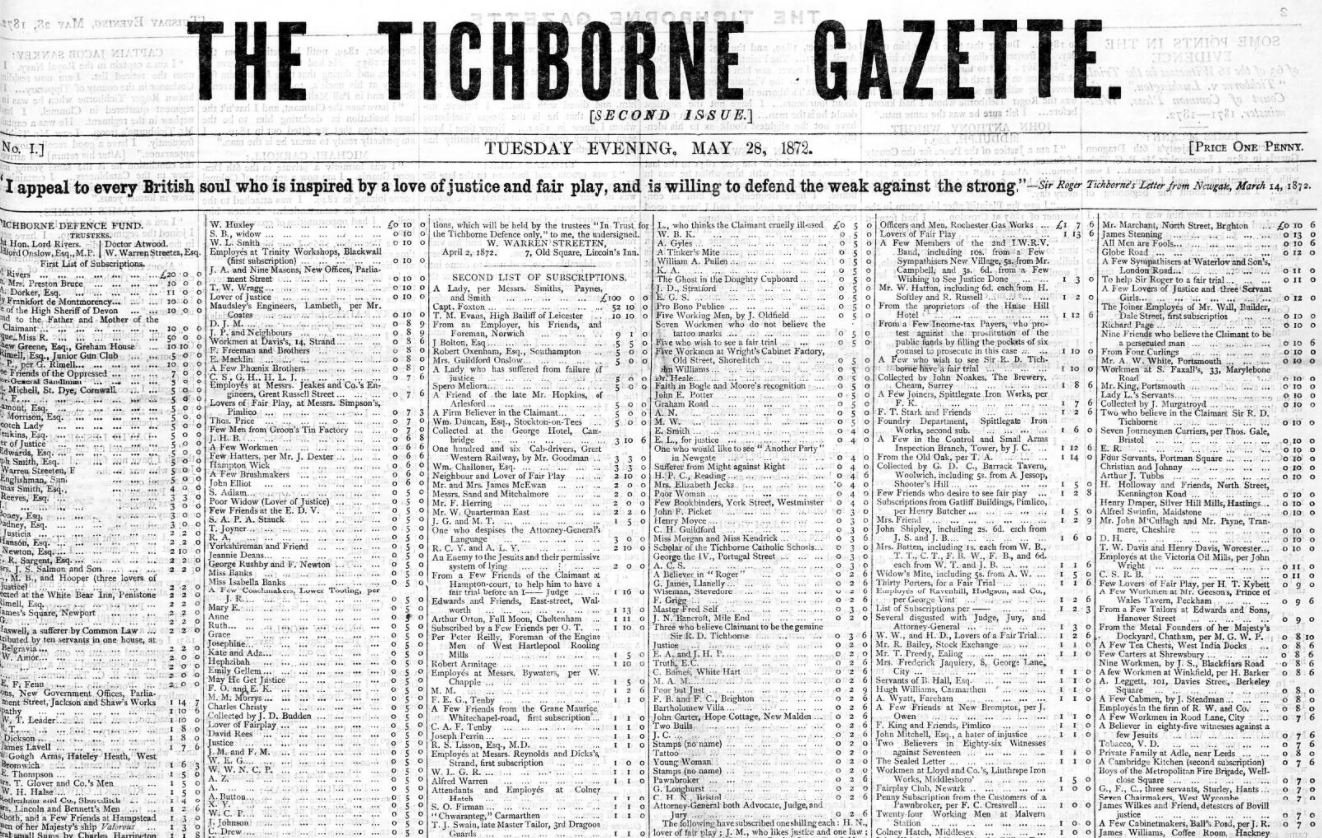
Her prayers were seemingly answered in 1866 when a Wagga Wagga butcher named Thomas Castro came forward and claimed to be Sir Roger Tichborne (he was henceforth known as the ‘Claimant).’ Lady Tichborne accepted him without question, but in 1871 a legal case was put forward that the Claimant was in fact Arthur Orton, a butcher’s boy from Wapping who had got lost in Australia.
Without the support of Lady Tichborne, who had died in 1868, the Claimant found himself imprisoned for perjury. Derided by the wider press, supporters of the purported Sir Roger Tichborne set up a newspaper to further his cause, the first edition of the Tichborne Gazette noting how:
No apology can be needed for a paper to be devoted wholly to the cause of Sir Roger Tichborne. The want of such a paper has been much felt, and inquiries for it have been innumerable.

So what did the newspaper contain? The first edition laid out this handy summary:
Our first page will be devoted wholly to our subscription list. The second page will contain the evidence reproduced of Sir Roger’s witnesses…the memorable eighty-six. The third and fourth pages will be occupied by a review of evidence given by Sir Roger’s opponents, leading artists, comments, correspondence, reports of meetings, opinions of the press, and other general news relating to the case.

Indeed, 86 people were prepared to testify that the Claimant really was Sir Roger Tichborne, with many also donating generously to his cause, subscribers using such pseudonyms as ‘Lover of Fair Play.’ That was what the Tichborne Gazette hoped to appeal to – the British Love of fair play – with this quote from the Claimant, spoken from Newgate, adorning the newspaper’s masthead:
I appeal to every British soul who is inspired by a love of justice and fair play, and is willing to defend the weak against the strong.

In June supporters of the Claimant produced another new newspaper dedicated to other perceived injustices, entitled the Anti-Oppression Journal. This publication lasted only four months, and the Tichborne Gazette was dissolved in October 1872. For the courts had found the Claimant to really be Arthur Orton, and the Claimant was sentenced to fourteen years in prison. He was released in 1884, and in 1895 he confessed to truly being Arthur Orton, but he quickly recanted this.
Arthur Orton, or Sir Roger Tichborne, depending on what you believe, died in poverty in 1898. It has never been conclusively proved that Orton was not Sir Roger Tichborne, and so there are some who believe that he was indeed the missing aristocrat, despite noticeable physical differences (the Claimant being famously heavy built, and Sir Roger being lean) and a certain roughness that the Claimant had in his manner. Also, when the Claimant returned to Britain, he visited Wapping, a nail in the coffin for the prosecution who believed him to be Arthur Orton, the butcher’s boy.

New Titles
Title |
Years Added |
| Cosmopolitan | 1865, 1868-1876 |
| Illustrated Crystal Palace Gazette | 1853-1854 |
| Illustrated Midland News | 1869-1871 |
| Illustrated Newspaper | 1871 |
| London Illustrated Weekly | 1874 |
| South London Advertiser | 1863-1866 |
| Surrey Herald and County Advertiser | 1826-1828 |
| Tichborne Gazette | 1872, 1874-1875 |
| Warminster Herald | 1857, 1859-1869, 1872-1874, 1877-1880, 1882-1884, 1886-1893 |
| Westerham Herald | 1883-1889, 1893-1896, 1898-1935 |
| Wolverton Express | 1901-1954 |
Updated Titles
This week we have updated eighteen of our existing titles.
You can learn more about each of the titles we add to every week by clicking on their names. On each paper’s title page, you can read a FREE sample issue, learn more about our current holdings, and our plans for digitisation.
Title |
Years Added |
| Borough of Greenwich Free Press | 1857 |
| Bury Free Press | 1997 |
| Fenland Citizen | 1989 |
| Grantham Journal | 1960-1967, 1981-1983, 1995-1996 |
| Haverhill Echo | 1994-1997 |
| Herne Bay Press | 1898 |
| Islington Times | 1858 |
| Kentish Express | 1878 |
| Liverpool Albion | 1837, 1851, 1859, 1865 |
| Lloyd’s List | 1913 |
| Music Hall and Theatre Review | 1902-1903 |
| New Milton Advertiser | 1992 |
| Newmarket Journal | 1997 |
| Saffron Walden Weekly News | 1997 |
| South Eastern Gazette | 1910 |
| Spalding Guardian | 1957, 1961-1963, 1995-1997 |
| Suffolk and Essex Free Press | 1997 |
| Wellington Gazette and Military Chronicle | 1879 |
You can keep up to date with all the latest additions by visiting the recently added page. You can even look ahead to see what we’re going to add tomorrow.




